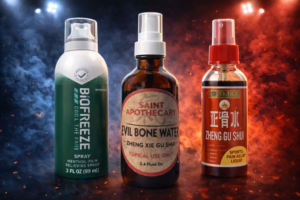The Corydalis plant (Yanhusuo) is a revered plant in Traditional Chinese Medicine (TCM), and has been a cornerstone for pain alleviation for centuries. Its roots, rich in the potent compound Berberine, provide natural pain relief and a host of other therapeutic benefits. The unique process of vinegar-treatment further amplifies the efficacy of Corydalis, making it an even more potent remedy in the world of natural healing. Dive into the ancient wisdom and modern applications of this remarkable plant.

The Corydalis Plant
Corydalis stands out for its beauty and medicinal potency because it is from the Papaveraceae family, commonly recognized for poppies. Native to China, its delicate tubular flowers come in delightful shades of red and purple. However, it’s not the flowers that have garnered the most attention – it’s the tuberous roots. These roots are packed with medicinal properties, long revered by practitioners of Traditional Chinese Medicine (TCM). And where does Corydalis thrive the most? Look to the cool, high-altitude regions of China’s northern provinces.
Corydalis in Traditional Chinese Medicine
In the realm of TCM, Corydalis serves multiple purposes:
Blood Invigoration: Encourages movement of the fluids in the body
Qi Movement: Aids in the movement of Qi or gases in the body
Pain Alleviation:It’s a sought-after remedy for a range of pains including menstrual discomfort, abdominal pain, and injury-related aches. Acting as a natural analgesic, it helps to promote blood flow while reducing pain.
Its warm and aromatic scent aids the movement of Qi. The plant’s heavy and firm stems and its beautiful red and purple flowers signal its role in the heart and liver’s blood level. It’s believed that its bitterness helps drain stasis, while its acrid nature disperses stagnation.
Properties: Acrid, Bitter, Warm
Channels: Heart, Liver, Stomach
Significance: Strongly invigorates blood and alleviates pain.
Benefits of Corydalis
Modern science has thrown its weight behind Corydalis, too. It’s found to help reduce pain perception by acting on dopamine receptors and stimulating opiate receptors. Two major players in pain management and relief are these cell receptor sites. The key compound behind this is dehydrocorybulbine. Additionally, the high concentrations of Berberine, which gives it its yellow color in the root, lend it anti-inflammatory properties and offer protection to nerve cells
Processing Corydalis for Potency
Interestingly, vinegar plays a pivotal role in enhancing the properties of Corydalis. Corydalis is even more effective when processed with vinegar, which regulates blood and reduces pain. The vinegar aids in releasing the primary active ingredients but also addresses the inherent solubility challenges posed by the alkaloids present.
Vinegar-soaked Corydalis enters the liver channel more directly and is better at regulating blood and stopping pain, the sour constricting effect of vinegar helps stop bleeding without affecting the stagnation-removing action of the herb. Modern research has shown that vinegar-soaked Coriolis has much increased alkaline solubility, which means that this method of preparation promotes the availability of primary active ingredients.
Vinegar-soaked Corydalis products are, therefore, becoming a preferred choice in clinical settings.
Quality Matters
Quality can be a spectrum when it comes to medicinal herbs like Corydalis. Not every sample, even if marked “medical grade,” packs the same medicinal punch.
In the early days of crafting Corydalis Relief Salve, sourcing small quantities of Yan Hu Suo and processing it with vinegar was an adventure. It caused persistent yellow stains on the countertops. A sign of the herb’s power, thanks to the berberine concentration.
Here is a Challenge
Given two piles of Yan Hu Suo, pick out the top-quality one.

While both would stain equally, a deeper brown hints at superior quality and optimal processing.
In wrapping up, the Botanical Ez Corydalis Relief Salve isn’t just a product; it’s a blend of ancient wisdom and modern science, promising genuine relief.
If you don’t like strong medicinal smells or menthol and camphor cooling sensations, then this is the product for you. I have found this product to work exceptionally well for diabetics or cancer-induced peripheral neuropathy.
Combine the synergistic effect of our two best-selling topicals. They work together in separate but complementary ways to quickly eliminate your pain.
About the Author
Willard Sheppy is a writer and healthcare practitioner who seamlessly melds scientific knowledge with practical applications in engaging and authoritative articles. He holds a Bachelor of Science in Environmental Science from Oregon State University and a Master’s in Acupuncture and Oriental Medicine from the distinguished Oregon College of Oriental Medicine.
In his work, Willard skillfully combines his extensive educational background in scientific research with his practical experience as a healthcare practitioner. Willard balances his life with martial arts and cherished family adventures. As a father of three, he often leads his family on camping and hiking trips along the breathtaking Oregon coast.
Connect with Willard on LinkedIn at linkedin.com/in/valleyhealthclinic or learn more about his services at valleyhealthclinic.com. Embark on this journey towards holistic health with Willard!










